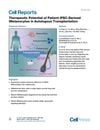A Randomized Pilot Study to Compare Hair Follicle Cell Suspensions Prepared Using Trypsin Alone Versus Trypsin in Combination with Collagenase Type I for Transplantation in Vitiligo
July 2019
in “
Clinical and experimental dermatology
”
TLDR Adding collagenase to trypsin improves cell yield and repigmentation in vitiligo treatment.
In a pilot study conducted on 22 patients with stable vitiligo, researchers compared the effectiveness of using trypsin alone versus a combination of trypsin and collagenase type I to prepare hair follicle cell suspensions for transplantation. The study was randomized and double-blind, with three treatment arms: trypsin plus collagenase, trypsin alone, and dermabrasion with vehicle alone. Each patient's hair follicle sample was divided and treated with both methods, then transplanted onto dermabraded patches, while a third patch received only the vehicle. Over a 6-month follow-up, the addition of collagenase resulted in a significant increase in cell yield and comparable cell viability. Although the increase in HMB45+ melanocytes and precursor stem cells was not statistically significant, the clinical repigmentation was greater in the group treated with both enzymes (33.22%) compared to trypsin alone (24.31%) and dermabrasion alone (16.59%), with the collagenase group showing significantly higher repigmentation than dermabrasion alone (P < 0.05). The study concluded that incorporating collagenase type I into the preparation of hair follicle cell suspensions enhances the retrieval of pigment-forming cells and improves repigmentation in vitiligo.



